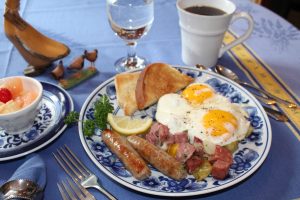Parfaits for breakfast? It sounds like it must be sweet. It is, but it’s full of fruit, tastes wonderfully, and it’s a fun, fresh beginning to breakfast.
This recipe combines two different recipes: one for a Zabaglione (from the Bauli Recipe Book); another for curried fruit (from the Much Ado About Food – A Guthrie Theater Cookbook).
First, you must make the curried fruit.
Ingredients:
• 2 ¼ cups peach halves, drained
• 2 ¼ cups pear halves, drained
• 2 ¼ cups apricot halves, drained
• 1 ½ cups pineapple chunks
• 1 fresh orange peeled and sectioned
• ¾ cup toasted slivered almonds
• ¼ cup sugar
• ¾ cup brown sugar
• T tsp. curry powder
Mixing:
• Drain fruit and pat dry between paper towels.
• Arrange fruits and nuts in 1 ½ to 2 qt. baking dish.
• Melt butter, brown sugar and curry.
• Mix well and pour over fruit and nuts.
• Bake at 325 degrees for 1 hour.
While the fruit is cooking, make the Zabaglione. (Note the completed Curried Fruit in the background)
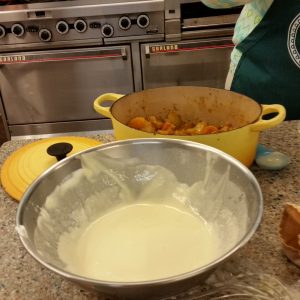
Ingredients:
• 6 large egg yolks
• 2/3 cup granulated sugar
• 1 cup Prosecco (can be omitted)
• 1 tsp pure vanilla extract
• ¾ cup heavy cream whipped
• 3-4 cups of Panettone (we’ve used extra muffins that are cubed – ½ half inch)
Mixing:
• In a large mixing bowl whisk the egg yolks and sugar until fluffy and pale yellow in color.
• Add the Prosecco and whisk until well blended.
• Transfer the mixture to the top of a double boiler, place over simmering warer and whisk constantly until the mixture is quite thick and heavily coats a spoon.
• Don’t let the mixture come to a boil or the eggs will curdle.
• Immediately transfer to a large mixing bowl and whisk in the vanilla.
• Refrigerate the zabaglione until completely cool.
• Fold in the whipped cream and chill until serving.
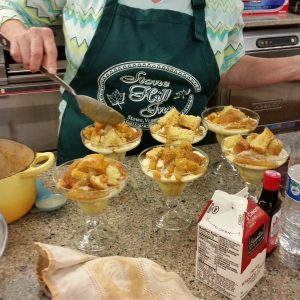
Assembly:
• To assemble the parfaits, you will need 6 tall glasses. (We prefer the ones you see above)
• Spoon about 2 heaping tablespoons of the zabaglione into the bottom of each glass.
• Top with a thick layer of the Panettone cubes, using about ¼ to 1/3 cup
• Add two heaping tablespoons of the curried fruit
• Layer more zabaglione, Pannettone and fruit.
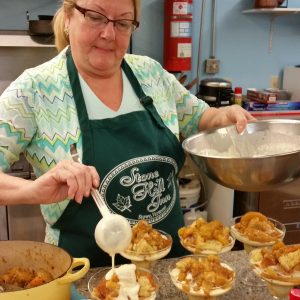
• Finish with one last pour of the zabaglione.
• If you have time (we didn’t) cover with plastic wrap and refrigerate for a couple of hour before serving.
• Also, if you like, top the chilled parfaits with a dollop of whipped cream and a sprinkling of almonds and fresh mint.
Serving:
Normally, we, at Stone Hill Inn, have a separate fruit course, fresh baked goods, yogurt and home-made granola as a starter for breakfast. We used this dish as a substitute for all of them!
The finished product…we didn’t bother with the whipped cream – it’s already plenty tasty!! (six servings):
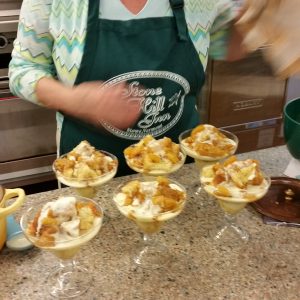
Finished product — six servings!



